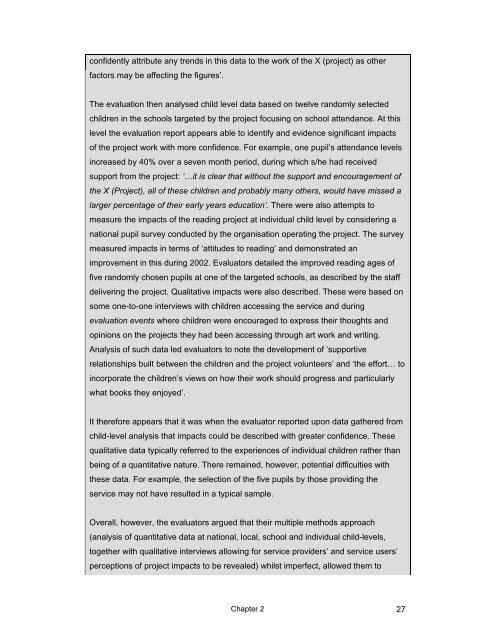Local Evaluation of Children's Services Learning from the Children's ...
Local Evaluation of Children's Services Learning from the Children's ...
Local Evaluation of Children's Services Learning from the Children's ...
- No tags were found...
Create successful ePaper yourself
Turn your PDF publications into a flip-book with our unique Google optimized e-Paper software.
confidently attribute any trends in this data to <strong>the</strong> work <strong>of</strong> <strong>the</strong> X (project) as o<strong>the</strong>rfactors may be affecting <strong>the</strong> figures’.The evaluation <strong>the</strong>n analysed child level data based on twelve randomly selectedchildren in <strong>the</strong> schools targeted by <strong>the</strong> project focusing on school attendance. At thislevel <strong>the</strong> evaluation report appears able to identify and evidence significant impacts<strong>of</strong> <strong>the</strong> project work with more confidence. For example, one pupil’s attendance levelsincreased by 40% over a seven month period, during which s/he had receivedsupport <strong>from</strong> <strong>the</strong> project: ‘…it is clear that without <strong>the</strong> support and encouragement <strong>of</strong><strong>the</strong> X (Project), all <strong>of</strong> <strong>the</strong>se children and probably many o<strong>the</strong>rs, would have missed alarger percentage <strong>of</strong> <strong>the</strong>ir early years education’. There were also attempts tomeasure <strong>the</strong> impacts <strong>of</strong> <strong>the</strong> reading project at individual child level by considering anational pupil survey conducted by <strong>the</strong> organisation operating <strong>the</strong> project. The surveymeasured impacts in terms <strong>of</strong> ‘attitudes to reading’ and demonstrated animprovement in this during 2002. Evaluators detailed <strong>the</strong> improved reading ages <strong>of</strong>five randomly chosen pupils at one <strong>of</strong> <strong>the</strong> targeted schools, as described by <strong>the</strong> staffdelivering <strong>the</strong> project. Qualitative impacts were also described. These were based onsome one-to-one interviews with children accessing <strong>the</strong> service and duringevaluation events where children were encouraged to express <strong>the</strong>ir thoughts andopinions on <strong>the</strong> projects <strong>the</strong>y had been accessing through art work and writing.Analysis <strong>of</strong> such data led evaluators to note <strong>the</strong> development <strong>of</strong> ‘supportiverelationships built between <strong>the</strong> children and <strong>the</strong> project volunteers’ and ‘<strong>the</strong> effort… toincorporate <strong>the</strong> children’s views on how <strong>the</strong>ir work should progress and particularlywhat books <strong>the</strong>y enjoyed’.It <strong>the</strong>refore appears that it was when <strong>the</strong> evaluator reported upon data ga<strong>the</strong>red <strong>from</strong>child-level analysis that impacts could be described with greater confidence. Thesequalitative data typically referred to <strong>the</strong> experiences <strong>of</strong> individual children ra<strong>the</strong>r thanbeing <strong>of</strong> a quantitative nature. There remained, however, potential difficulties with<strong>the</strong>se data. For example, <strong>the</strong> selection <strong>of</strong> <strong>the</strong> five pupils by those providing <strong>the</strong>service may not have resulted in a typical sample.Overall, however, <strong>the</strong> evaluators argued that <strong>the</strong>ir multiple methods approach(analysis <strong>of</strong> quantitative data at national, local, school and individual child-levels,toge<strong>the</strong>r with qualitative interviews allowing for service providers’ and service users’perceptions <strong>of</strong> project impacts to be revealed) whilst imperfect, allowed <strong>the</strong>m toChapter 2 27
















